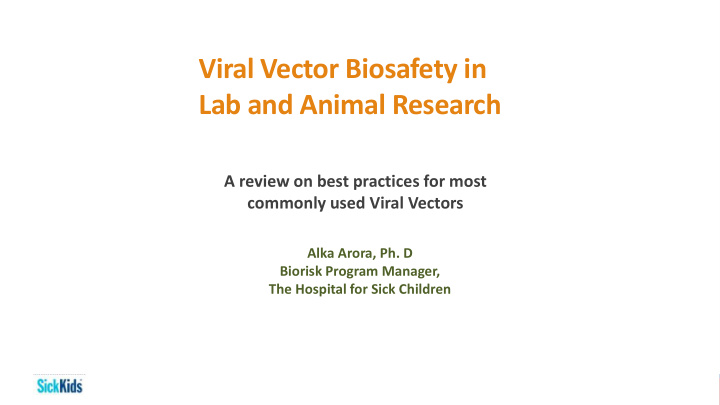



Viral Vector Biosafety in Lab and Animal Research A review on best practices for most commonly used Viral Vectors Alka Arora, Ph. D Biorisk Program Manager, The Hospital for Sick Children
Gene Therapy GT is the introduction of genes into existing cells to prevent or cure a wide range of diseases. There are several approaches to gene therapy: • Replacing mutated gene with a healthy copy of the gene e.g. ADA-SCID. • Inactivating or "knocking out" a mutated gene. • Introducing a new gene into the cells to help fight a disease, e.g tumor suppressor gene p53.
Gene Therapy Gene therapy utilizes the delivery of DNA into cells, which can be accomplished by • Naked DNA or DNA complexes- non viral methods • Recombinant viruses- viral vector Why Use Viruses? • Viruses are very efficient in transferring their genetic material into host cells • Specific target cell: depending on the attachment proteins
Risk Assessment
Risk group of the parent virus from which the vector originated Risk Assessment Tropism : the specificity of a virus for a host tissue Pseudotyping replace the envelope proteins on the virus by envelope proteins from other viruses to limit or expand the viral tropism
Risk of Insertional Mutagenesis Random integration of viral genome may disrupt the endogenous host genes Inactivation of a tumor suppressor gene Virus vector TS gene Gen DNA Gen DNA Target Cell
Rescue of Replication Deficient Virus Virus vector Wild type virus x Gen DNA Gen DNA Target Cell Vector-transduced cells may be infected by a wild type . lentivirus which can potentially act as a helper virus to rescue the integrated vector
Nature of transgene: Any gene which can significantly alter the cell cycle when over- expressed is a gene of concern. Risk Assessment Stability in the Environment: Lipid enveloped viruses are more sensitive to inactivation and disinfection.
Volume generated and Aerosol Generating Procedures : e.g. ultracentrifugation, , homogenization etc. Risk Assessment Animal Host and Manipulation: - Host, animals engrafted with human cells. -Use of sharps for administration of viral vectors and surgery etc.
Features AAV Adenovirus HSV Retrovirus Lentivirus Rabies –G (gamma deleted virus retroviruses) Virus coat Non-Enveloped Non-Enveloped Enveloped Enveloped Enveloped Enveloped Genome ssDNA dsDNA dsDNA ssRNA (+) ssRNA (+) ssRNA (-) Risk group 1 2 2 2 3 3 Infection range Dividing and Dividing Dividing and Dividing Dividing and non dividing non dividing and non non dividing non dividing cells- Neurons dividing NEU Host Genome Mostly non- Non integrating Non Integrate into Integrates Non integrating interaction integrating integrating host genome into host genome Stability in the High stability High stability Unstable, Unstable, Unstable. Unstable. environment Remain 3-8 wks at RT rapidly rapidly Rapidly Rapidly inactivat infectious for a inactivated inactivated, inactivated ed outside their month at RT outside the sensitive to outside their hosts host, highly dehydration hosts susceptible to dehydration Disinfectants 10% bleach for liquid waste AHP surface disinfection
Viral Route of Transmission Host Range Lab Containment level Animal work Containment Containment Level Vector Level AAV Ingestion, Broad host CL1- based on risk assessment CL-1 housing; CL-2 housing in the presence Mucous membrane range, infective Packaging: helper plasmid of helper virus. Parenteral for many cell CL 2 : based on risk types including assessment neurons Packaging: helper virus Adenov Inhalation Broad host CL2 CL2 housing irus mucous range, infective membrane, for many cell parenteral, direct types contact, CL-2 housing. HSV Direct contact, Respirator Broad host range CL2 Amplicon-only is CL-1 y droplets, mucous membrane exposure Parenteral
Containment Level Viral Route Host Range Lab Containment level Animal CL Vector of Transmission Retrovirus Parenteral inoculation, M CL-1 (ecotropic), CL-1 housing Ecotropic CL-2 (amphotropic) for ecotropic, ucous membrane CL-2 for exposure Pantropic- VSV-G amphotropic contact exposure pseudotyped of broken skin In rodents Lentivirus Mucous membrane, Broad host range, CL2 : based on risk without human Parenteral, infective for many cell assessment cells present: Direct contact, types CL2+: based on risk CL2 assessment Rabies G Parenteral injection Broad host range CL2 CL2 deleted virus Mucous membranes Contact exposure of brok en skin
Recommend
More recommend